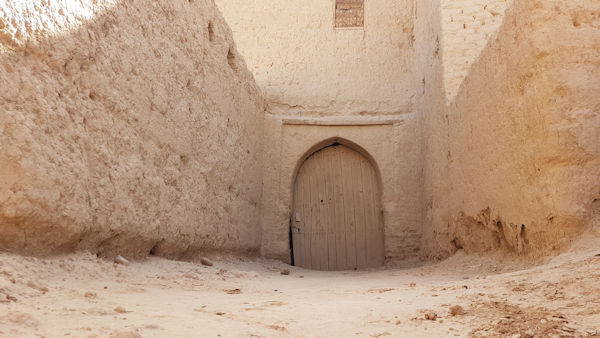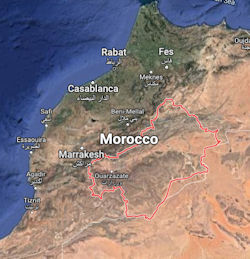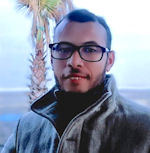SEJournal Online is the digital news magazine of the Society of Environmental Journalists. Learn more about SEJournal Online, including submission, subscription and advertising information.
 |
| A doorway in the wall of an abandoned village in the oasis of Es-Sfalat Tafilalet, Morocco. Prolonged drought has driven many people from their homes in this region. Photo: Khalid Bencherif. Click to enlarge. |
Feature: Covering Climate Change in the Forgotten Places: A Moroccan Journalist’s View
By Khalid Bencherif
In North Africa, a region full of difficult problems, including poverty, inequality, political tyranny, corruption, hunger and disease, the last thing that gets noticed is climate change.
 |
| The Tafilalet region of Morocco. Image: Google Maps. Click to enlarge. |
So as a journalist from Morocco, I wondered if I should write about the topic at all. In the end, the answer was an easy “yes.”
In part, that was because I preferred to stay away from the sensitive subjects of politics and corruption. But it was also because North Africa and the Middle East are among the most water-scarce places on Earth. I was determined to find an effective way to communicate with local audiences about all this “climate change nonsense.”
At first, my articles on climate change and the environment didn't get any attention from my intended audience. When I realized that they weren’t responding to numbers and facts, I tried something different.
I wrote a much more personal story, about returning to Tafilalet, the oasis community in southeastern Morocco where I grew up, parts of which are now abandoned due to climate change-induced drought.
A focus on the human side
I wrote in a narrative style, recounting step by step my journey back to my childhood home. I also focused on real stories lived by ordinary people, to show the audience firsthand the effects of climate change.
I described the terrible things caused by climate change that I had seen, and I spoke with the people of the area to find out how the drought had destroyed their livelihoods and displaced them from their homes.
My hope was to reach readers’ hearts
and convince them that climate change
is not nonsense, but a real thing that
affects ordinary people’s lives.
My hope was to reach readers’ hearts and convince them that climate change is not nonsense, but a real thing that affects ordinary people’s lives.
Seeing the bigger picture
Religious societies in general, including North African societies, view natural phenomena as predictable and inevitable events that people can do nothing but surrender to. Yet this fatalistic view allows governments and stakeholders to escape from responsibility and accountability.
 |
| The earthen walls of an unoccupied kasbah in Es-Sfalat Tafilalet, Morocco. Without residents, oasis villages like this one fall into disrepair and are vulnerable to damage by pillagers. Photo: Khalid Bencherif. Click to enlarge. |
So I tried to show climate change as a phenomenon that we can deal with, and that governments and companies bear some responsibility for, whether by causing it or failing to combat it, in ways that can border on human rights violations.
But I also know that when climate change is seen as the only player on the field, we can miss other factors that may be contributing to the problem we’re covering.
In working on my story, I carefully tried to determine the role of climate change — without exaggeration — in the drought of the Tafilalet region. I actually found that other nonclimate factors, such as marginalization and poor water management, had a significant impact on the outcome of the drought.
I know, too, that at times everyone — from businessmen to politicians — attempts to use climate change for profit and advantage, with green projects and policies polishing their images. Some companies try to cover up their corrupt activities by adopting green practices. And some authoritarian governments even try to whitewash their human rights record through climate diplomacy.
At times, green technologies can actually worsen climate change effects. For example, I found that countless, cost-free solar-powered well pumps had a major role in draining the Tafilalet region’s aquifer.
The truth is that climate change is a sad story that particularly affects the poorest people in the most marginalized areas — the people who are the most vulnerable to its effects. So, for me, the best climate change stories are those that highlight its repercussions in the most forgotten and deprived areas.
That’s what inspired my reporting trip to Es-Sfalat Tafilalet, a part of the Tafilalet region that is barely known even to most Moroccans. As I learned, while Morocco in general is suffering from the effects of drought, the oases of Tafilalet in particular are experiencing serious water supply and quality problems due to climate change and human activities.
Follow the thread to the end
Climate change can have endless impacts on people's lives, but these effects are not always easily seen. Journalists must dig deep to see how people are affected in the medium and long term.
As I learned when researching my story, the drought in the Tafilalet region has turned village life upside down and prompted mass migration to cities. This displacement, which started in the 1990s, has affected the mental health of many rural migrants, particularly those in my parents’ generation. In addition to their environmental grief, they have had to deal with racism, harassment, fraud, exploitation, substandard working and housing conditions, and a high cost of living.
Beyond these personal impacts, the displacement caused by the drought is also leading to loss of local cultural identity and of wider Moroccan cultural heritage. Homes in the empty kasbahs (earthen-walled villages) are falling into disrepair, and are being further damaged by treasure hunters and antiquities thieves.
There is a desperate need to raise awareness about climate change issues in North Africa and the Middle East. Local journalists like me who are intimate with the region can play a vital role in conveying forgotten environmental stories to the rest of the world.
This trip to my birthplace was more than mere press coverage. It was my reconciliation with the memories of the place where I grew up. For me, climate change, corruption and marginalization are not just passing problems. They are personal.
 |
SEJ member Khalid Bencherif is a freelance journalist from Morocco, specializing in covering environmental, political and social issues in North Africa and the Middle East. He won an investigative reporting award from the Prometheus Institute in partnership with Oxfam in Morocco for a Sasapost story on the impacts of COVID-19 on the Moroccan economy and has received reporting grants from the Candid Foundation, Earth Journalism Network’s Biodiversity Media Initiative and Justice for Journalists. Bencherif is working to establish an eLearning environmental journalism platform project for journalists in North Africa. His story on Tafilalet was published in In These Times.
* From the weekly news magazine SEJournal Online, Vol. 7, No. 5. Content from each new issue of SEJournal Online is available to the public via the SEJournal Online main page. Subscribe to the e-newsletter here. And see past issues of the SEJournal archived here.














 Advertisement
Advertisement 



